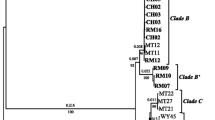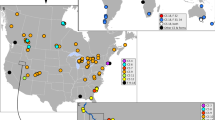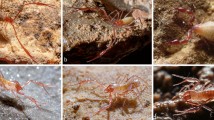Abstract
One of the current challenges facing conservation biologists is a lack of resolution of species boundaries in threatened groups residing in at-risk areas. This is particularly key for habitats like calcareous outcrops that are known to harbor a high degree of endemic species that may also possess extensive morphological variation. Here, we construct the first time-calibrated phylogeny and evaluate species number of the limestone endemic Mountainsnails (Oreohelicidae), a highly-threatened and phenotypically variable family of land snails from Western North America, using sequence fragments of the mitochondrial gene Cytochrome Oxidase subunit I (COI) from 50 recognized taxonomic species and subspecies. We found four highly supported clades that span wide geographic areas from southern Canada to northern Mexico. Using three species delimitation approaches, we identified a largely concordant set of 16 putative species, which represents less than a third the expected number of species given the current taxonomy and our dataset composition. Our results reveal that this is largely a result of two of the delimitation approaches lumping much of the taxonomic diversity of Oreohelicidae into a single species that possesses remarkable shell form variation and convergence. Moreover, we discuss the suitability of these approaches to delimiting clades with recent divergence, which is not uncommon for limestone endemic fauna and flora. To improve management decisions in montane limestone endemics, our research highlights the need for increased molecular and ecological studies of these isolated and phenotypically variable species.



Similar content being viewed by others
Change history
05 October 2020
The original version of this article unfortunately contained several mistakes.
References
Alonso MR, López-Alcántara A, Rivas P, Ibáñez M (1985) A biogeographic study of Iberus gualtierianus (L.) (Pulmonata: Helicidae). Soosiana 13:1–10
Baskin JM, Baskin CC (1988) Endemism in rock outcrop plant communities of unglaciated Eastern United States: an evaluation of the roles of the edaphic, genetic and light factors. J Biogeogr 15:829. https://doi.org/10.2307/2845343
Bauer LJ (1989) Moorland Beetle Communities on limestone habitat islands. I. Isolation, invasion and local species diversity in carabids and staphylinids. J Anim Ecol 58:1077. https://doi.org/10.2307/5143
Burbrink FT, Yao H, Ingrasci M, Bryson RW Jr, Guiher TJ, Ruane S (2011) Speciation at the Mogollon Rim in the Arizona Mountain Kingsnake (Lampropeltis pyromelana). Mol Phylogenet Evol 60(3):445–454. https://doi.org/10.1016/j.ympev.2011.05.009
Burke TE, Leonard WP (2013) Land snails and slugs of the Pacific Northwest. Oregon State University Press, Corvallis, OR
Conti E, Soltis DE, Hardig TM, Schneider J (1999) Phylogenetic relationships of the silver saxifrages (Saxifraga, Sect. Ligulatae Haworth): implications for the evolution of substrate specificity, life histories, and biogeography. Mol Phylogenet Evol 13:536–555. https://doi.org/10.1006/mpev.1999.0673
Cardinale BJ, Hillebrand H, Harpole WS et al (2009) Separating the influence of resource ‘availability’ from resource ‘imbalance’ on productivity-diversity relationships. Ecol Lett 12:475–487. https://doi.org/10.1111/j.1461-0248.2009.01317.x
Chak TCS (2007) Phylogenetic relationships and population differentiation of Oreohelix landsnails in Wyoming and adjacent South Dakota. Dissertation. University of Wyoming
Che-Castaldo JP, Neel MC (2016) Species-level persistence probabilities for recovery and conservation status assessment. Conserv Biol 30:1297–1306. https://doi.org/10.1111/cobi.12728
Clements R, Sodhi NS, Schilthuizen M, Ng PK (2006) Limestone karsts of Southeast Asia: imperiled arks of biodiversity. Bioscience 56(9):733. https://doi.org/10.1641/0006-3568(2006)56[733:lkosai]2.0.co;2
Cline LC, Hobbie SE, Madritch MD, Buyarski CR, Tilman D, Cavender-Bares JM (2018) Resource availability underlies the plant-fungal diversity relationship in a grassland ecosystem. Ecology 99:204–216. https://doi.org/10.1002/ecy.2075
Corlett RT, Tomlinson KW (2020) Climate change and edaphic specialists: irresistible force meets immovable object? Trends Ecol Evol 35(4):367–376. https://doi.org/10.1016/j.tree.2019.12.007
Crandall KA, Bininda-Emonds OR, Mace GM, Wayne RK (2000) Considering evolutionary processes in conservation biology. Trends Ecol Evol 15(7):290–295. https://doi.org/10.1016/s0169-5347(00)01876-0
Dempsey ZW, Goater CP, Burg TM (2020) Living on the edge: comparative phylogeography and phylogenetics of Oreohelix land snails at their range edge in Western Canada. BMC Evoluti Biol 20(1):3
Drummond AJ, Rambaut A (2007) BEAST: Bayesian evolutionary analysis by sampling trees. BMC Evolut Biol 7(1):214
Elejalde MA, Madeira MJ, Arrebola JR, Munoz B, Gómez-Moliner BJ (2008) Molecular phylogeny, taxonomy and evolution of the land snail genus Iberus (Pulmonata: Helicidae). J Zool Syst Evol Res 46:193–202. https://doi.org/10.1111/j.1439-0469.2008.00468.x
Emberton KC (1991) Polygyrid relations: a phylogenetic analysis of 17 subfamilies of land snails (Mollusca: Gastropoda: Stylommatophora). Zool J Linnean Soc 103(3):207–224. https://doi.org/10.1111/j.1096-3642.1991.tb00903.x
Erskine P, Ent AVD, Fletcher A (2012) Sustaining metal-loving plants in mining regions. Science 337:1172–1173. https://doi.org/10.1126/science.337.6099.1172-b
Fairbanks HL (1975) A taxonomic study of Oreohelix haydeni in western Montana. Masters thesis, University of Montana, Montana, USA.
Federal Register (2005) Endangered and threatened wildlife and plants; 90-day finding on a petition to list the Uinta mountainsnail as endangered. Fed Reg 71:69303–69305
Federal Register (2006) Endangered and threatened wildlife and plants; 90-day finding on a petition to list the black hills mountainsnail as threatened or endangered. Fed Reg 70:9988–9999
Federal Register (2011) Endangered and threatened wildlife and plants; 12-month finding on a petition to list the bearmouth mountainsnail, byrne resort mountainsnail, and meltwater lednian stonefly as endangered or threatened. Fed Reg 75:18684–18701
Felsenstein J (1988) Phylogenies from molecular sequences: inference and reliability. Annu Rev Genet 22:521–565. https://doi.org/10.1146/annurev.genet.22.1.521
Folmer O (1994) DNA primers for amplification of mitochondrial cytochrome c oxidase subunit I from diverse metazoan invertebrates. Mol Mar Biol Biotech 3:294–299
Frankham R, Ballou JD, Dudash MR, Eldridge MD, Fenster CB, Lacy RC, Mendelson JR III, Porton IJ, Ralls K, Ryder OA (2012) Implications of different species concepts for conserving biodiversity. Biol Conserv 153:25–31. https://doi.org/10.1016/j.biocon.2012.04.034
Frest TJ, Johannes EJ (1997) Land snail survey of the lower Salmon River drainage. Bureau of Land Management, Idaho State Office, Idaho
Fujisawa T, Barraclough TG (2013) Delimiting species using single-locus data and the generalized mixed yule coalescent approach: a revised method and evaluation on simulated data sets. Syst Biol 62(5):707–724
Geffen E, Anderson MJ, Wayne RK (2004) Climate and habitat barriers to dispersal in the highly mobile grey wolf. Mol Ecol 13:2481–2490. https://doi.org/10.1111/j.1365-294x.2004.02244.x
Giokas S (2000) Congruence and conflict in Albinaria (Gastropoda, Clausiliidae). A review of morphological and molecular phylogenetic approaches. Belg J Zool 130:93–100
Giokas S (2008) Shell surface adaptations in relation to water management in rock-dwelling land snails, Albinaria (Pulmonata: Clausiliidae). J Nat Hist 42:451–465. https://doi.org/10.1080/00222930701835407
Gittenberger E (1991) What about non-adaptive radiation? Biol J Lin Soc 43:263–272. https://doi.org/10.1111/j.1095-8312.1991.tb00598.x
Haskell DG, Pan JW (2013) Phylogenetic analysis of threatened and range-restricted limestone specialists in the land snail genus Anguispira. Conserv Genet 14:671–682. https://doi.org/10.1007/s10592-013-0460-4
Heled J, Drummond AJ (2009) Bayesian inference of species trees from multilocus data. Mol Biol Evol 27:570–580. https://doi.org/10.1093/molbev/msp274
Henderson J (1918) On the North American genus Oreohelix. J Mollusc Stud 13:21–24. https://doi.org/10.1093/oxfordjournals.mollus.a063671
Jackson ND, Carstens BC, Morales AE, O’Meara BC (2017) Species delimitation with gene flow. Syst Biol 66(5):799–812
Kapli P, Lutteropp S, Zhang J, Kobert K, Pavlidis P, Stamatakis A, Flouri T (2017) Multi-rate Poisson tree processes for single-locus species delimitation under maximum likelihood and Markov chain Monte Carlo. Bioinformatics 33(11):1630–8
Katoh K, Rozewicki J, Yamada KD (2019) MAFFT online service: multiple sequence alignment, interactive sequence choice and visualization. Brief Bioinform 20:1160–1166. https://doi.org/10.1093/bib/bbx108
Kruckeberg AR (1986) An essay: the stimulus of unusual geologies for plant speciation. Syst Bot 11:455. https://doi.org/10.2307/2419082
Labaune C, Magnin F (2002) Pastoral management vs. land abandonment in Mediterranean uplands: impact on land snail communities. Glob Ecol Biogeogr 11(3):237–245. https://doi.org/10.1046/j.1466-822x.2002.00280.x
Leaché AD, Fujita MK, Minin VN, Bouckaert RR (2014) Species delimitation using genome-wide SNP data. Syst Biol 63:534–542. https://doi.org/10.1093/sysbio/syu018
Love JD (1989) Names and descriptions of new and reclassified formations in northwestern Wyoming. Professional paper 932-C. U.S. Geological Survey, Washington, DC
Mace GM (2004) The role of taxonomy in species conservation. Philos Trans R Soc Lond B 359:711–719
Minin V, Abdo Z, Joyce P, Sullivan J (2003) Performance-based selection of likelihood models for phylogeny estimation. Syst Biol 52:674–683. https://doi.org/10.1080/10635150390235494
Miranda M, Burris P, Bingcang JF, Shearman P, Briones JO, La Viña A, Menard S, Kool J, Miclat S, Mooney C, Resueño A (2003) Mining and critical ecosystems: mapping the risks. World Resources Institute, Washington, DC
Monaghan MT, Wild R, Elliot M, Fujisawa T, Balke M, Inward DJ, Vogler AP (2009) Accelerated species inventory on madagascar using coalescent-based models of species delineation. Syst Biol 58(3):298–311. https://doi.org/10.1093/sysbio/syp027
Moritz C (2002) Strategies to protect biological diversity and the evolutionary processes that sustain it. Syst Biol 51(2):238–254
Murguía DI, Bringezu S, Schaldach R (2016) Global direct pressures on biodiversity by large-scale metal mining: spatial distribution and implications for conservation. J Environ Manag 180:409–420. https://doi.org/10.1016/j.jenvman.2016.05.040
NatureServe (2019) NatureServe explorer: an online encyclopedia of life [web application]. Version 7.0. NatureServe, Arlington
Nekola JC (2014) Overview of the North American terrestrial Gastropod Fauna. Am Malacol Bull 32:225. https://doi.org/10.4003/006.032.0203
Paradis E, Schliep K (2018) ape 5.0: an environment for modern phylogenetics and evolutionary analyses in R. Bioinformatics 35:526–528. https://doi.org/10.1093/bioinformatics/bty633
Paridon BJV, Gilleard JS, Colwell DD, Goater CP (2017) Life cycle, host utilization, and ecological fitting for invasive lancet liver fluke, Dicrocoelium dendriticum, emerging in southern Alberta, Canada. J Parasitol 103:207–212. https://doi.org/10.1645/16-140
Pierce HG, Constenius KN (2001) Late Eocene-Oligocene nonmarine mollusks of the northern Kishenehn Basin, Montana and British Columbia. Ann Carnegie Mus 70(1):1–112
Pilsbry HA (1939) Land mollusca of North America. Academy of Natural Sciences, Philadelphia
Pons J, Barraclough TG, Gomez-Zurita J, Cardoso A, Duran DP, Hazell S, Kamoun S, Sumlin WD, Vogler AP (2006) Sequence-based species delimitation for the DNA taxonomy of undescribed insects. Syst Biol 55(4):595–609
Ports MA (2004) Biogeographic and taxonomic relationships among the mountain snails (Gastropoda: Oreohelicidae) of the central Great Basin. Western North American Naturalist, pp 145–154
Puillandre N, Lambert A, Brouillet S, Achaz G (2012) ABGD, automatic barcode gap discovery for primary species delimitation. Mol Ecol 8:1864–77
R Core Team (2019) R: a language and environment for statistical computing, version 331. R Foundation for Statistical Computing, Vienna
Rajakaruna N (2004) The edaphic factor in the origin of plant species. Int Geol Rev 46:471–478. https://doi.org/10.2747/0020-6814.46.5.471
Rajakaruna N (2017) Lessons on evolution from the study of edaphic specialization. Bot Rev 84:39–78. https://doi.org/10.1007/s12229-017-9193-2
Rambaut A, Drummond AJ, Xie D, Baele G, Suchard MA (2018) Posterior summarization in Bayesian phylogenetics using tracer 1.7. Syst Biol 67:901–904. https://doi.org/10.1093/sysbio/syy032
Rannala B, Yang Z (2017) Efficient Bayesian species tree inference under the multispecies coalescent. Syst Biol. https://doi.org/10.1093/sysbio/syw119
Reid NM, Carstens BC (2012) Phylogenetic estimation error can decrease the accuracy of species delimitation: a Bayesian implementation of the general mixed Yule-coalescent model. BMC Evol Biol 12:196. https://doi.org/10.1186/1471-2148-12-196
Roth B, Emberton KC (1994) "Extralimital" land mollusks (Gastropoda) from the Deep River Formation, Montana: evidence for mesic medial tertiary climate. Proc Acad Nat Sci Phila 145:93–106
Roth B (1986) Land mollusks (Gastropoda, Pulmonata) from Early Tertiary Bozeman Group, Montana. Proc Calif Acad Sci 44:237–267
Schilthuizen M (1994) Reproductive isolation in snails of the genus Albinaria (Gastropoda: Clausiliidae). Biol J Lin Soc 52:317–324. https://doi.org/10.1111/j.1095-8312.1994.tb00994.x
Solem A (1975) Notes on Salmon River Valley oreohelicid land snails, with description of Oreohelix waltoni. The Veliger 18(1):16–30
Sonter LJ, Ali SH, Watson JEM (2018) Mining and biodiversity: key issues and research needs in conservation science. Proc R Soc B 285:20181926. https://doi.org/10.1098/rspb.2018.1926
Stamatakis A (2006) RAxML-VI-HPC: maximum likelihood-based phylogenetic analyses with thousands of taxa and mixed models. Bioinformatics 22:2688–2690. https://doi.org/10.1093/bioinformatics/btl446
Storch D, Evans KL, Gaston KJ (2005) The species-area-energy relationship. Ecol Lett 8:487–492. https://doi.org/10.1111/j.1461-0248.2005.00740.x
Swofford DL, Sullivan J (2003) Phylogeny inference based on parsimony and other methods using PAUP. In: Salemi M, Vandamme A-M (eds) The phylogenetic handbook. Springer, New York, pp 267–312
Talavera G, Dincă V, Vila R (2013) Factors affecting species delimitations with the GMYC model: insights from a butterfly survey. Methods Ecol Evol 4(12):1101–1110. https://doi.org/10.1111/2041-210x.12107
Teshima H, Davison A, Kuwahara Y, Yokoyama J, Chiba S, Fukuda T, Ogimura H, Kawata M (2003) The evolution of extreme shell shape variation in the land snail Ainohelix editha: a phylogeny and hybrid zone analysis. Mol Ecol 12:1869–1878. https://doi.org/10.1046/j.1365-294x.2003.01862.x
Tropek R, Kadlec T, Karesova P, Spitzer L, Kocarek P, Malenovsky I, Banar P, Tuf IH, Hejda M, Konvicka M (2010) Spontaneous succession in limestone quarries as an effective restoration tool for endangered arthropods and plants. J Appl Ecol 47:139–147. https://doi.org/10.1111/j.1365-2664.2009.01746.x
Van Riel P, Jordaens K, Van Houtte N, Martins AM, Verhagen R, Backeljau T (2005) Molecular systematics of the endemic Leptaxini (Gastropoda: Pulmonata) on the Azores islands. Mol Phylogenetics Evol 37(1):132–143
Wang J, Ai B, Kong H, Kang M (2017) Speciation history of a species complex of Primulina eburnea (Gesneriaceae) from limestone karsts of southern China, a biodiversity hot spot. Evol Appl 10:919–934. https://doi.org/10.1111/eva.12495
Watson SA, Peck LS, Tyler PA, Southgate PC, Tan KS, Day RW, Morley SA (2012) Marine invertebrate skeleton size varies with latitude, temperature and carbonate saturation: implications for global change and ocean acidification. Glob Change Biol 18:3026–3038. https://doi.org/10.1111/j.1365-2486.2012.02755.x
Weaver KF (2006) Biogeography, systematics, and conservation genetics in the mountain snail group Oreohelix (Oreohelicidae). PhD thesis, University of Colorado, CO, USA
Weaver KF, Perez-Losada M, Guralnick RP, Nelson A, Blatt S, Crandall KA (2008) Assessing the conservation status of the land snail Oreohelix periphericawasatchensis (family Oreohelicidae). Conserv Genet 9:907–916. https://doi.org/10.1007/s10592-007-9415-y
Weaver KF, Weaver PF, Guralnick R (2010) Origin, diversification and conservation status of talus snails in the Pinaleño Mountains: a conservation biogeographic study. Anim Conserv 13(3):306–314. https://doi.org/10.1111/j.1469-1795.2009.00341.x
Xia X (2018) DAMBE7: new and improved tools for data analysis in molecular biology and evolution. Mol Biol Evol 35:1550–1552. https://doi.org/10.1093/molbev/msy073
Xia X, Xie Z, Salemi M, Chen L, Wang Y (2003) An index of substitution saturation and its application. Mol Phylogenet Evol 26:1–7. https://doi.org/10.1016/s1055-7903(02)00326-3
Zhang J, Kapli P, Pavlidis P, Stamatakis A (2013) A general species delimitation method with applications to phylogenetic placements. Bioinformatics 29(22):2869–2876
Acknowledgements
We are grateful to Joel Sauder, Kate Holcomb, Jeff Sorenson, Samantha Ferguson, and Christina Sato for facilitating permits and providing logistic support while conducting fieldwork in Idaho, Utah, Arizona, New Mexico, and Washington, respectively. This work would not have been possible without the diligent collections or information provided by a number of academic and public field personnel: Lusha Tronstad, Paul Hendricks, Tom Burke, Hillary Boyd, Bill Gaines, Ann Sprague, Judy Hoder, Janet Millar, Eric Wagner, and Kevin Wheeler. Special thanks are given to Mark A. Ports for several stimulating discussions and providing a number of samples from the state of Nevada. We would also like to acknowledge the support of Heather Robeson and the University of Colorado Museum of Natural History for providing samples. Additional collection samples were provided by John Slapcinsky and the University of Florida Museum of Natural History. We are grateful to John Phillips, Kelly Martin, and Nicole Recla for comments on an earlier version of the manuscript. This work was funded by an an NSF Graduate Research Fellowship program award to T. Mason Linscott (NSF 1842399) and awards from the National Geographic Society, Washington Forest Service Interagency Special Status/Sensitive Species Program, and South Dakota Fish and Wildlife to Kathleen Weaver. Research reported in this publication was also supported by an Institutional Development Award (IDeA) from the National Institute of General Medical Sciences of the National Institutes of Health under grant number P30 GM103324 to Christine E. Parent.
Author information
Authors and Affiliations
Corresponding author
Additional information
Publisher's Note
Springer Nature remains neutral with regard to jurisdictional claims in published maps and institutional affiliations.
Electronic supplementary material
Below is the link to the electronic supplementary material.
Rights and permissions
About this article
Cite this article
Linscott, T.M., Weaver, K., Morales, V. et al. Assessing species number and genetic diversity of the Mountainsnails (Oreohelicidae). Conserv Genet 21, 971–985 (2020). https://doi.org/10.1007/s10592-020-01302-5
Received:
Accepted:
Published:
Issue Date:
DOI: https://doi.org/10.1007/s10592-020-01302-5




